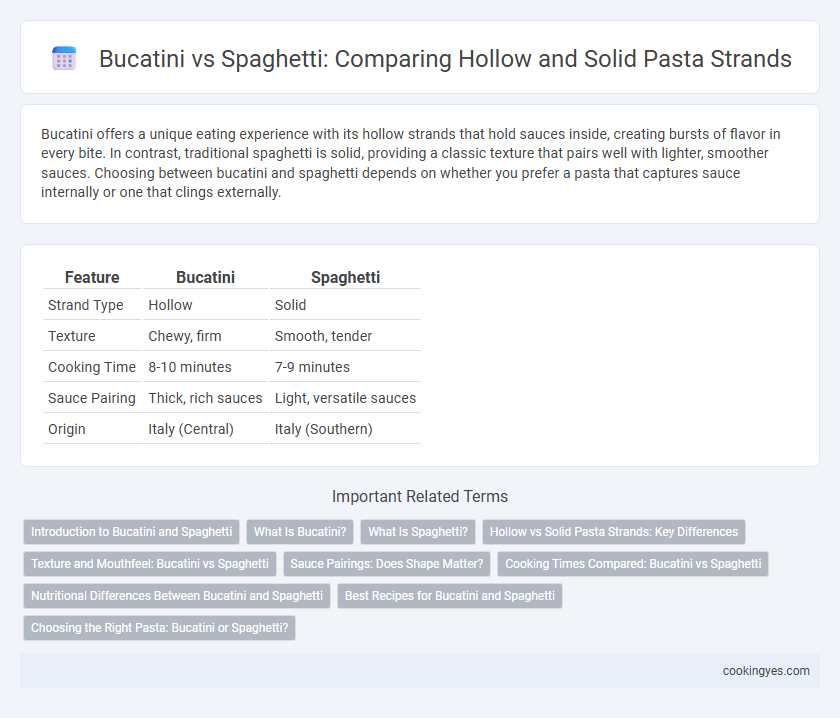Bucatini offers a unique eating experience with its hollow strands that hold sauces inside, creating bursts of flavor in every bite. In contrast, traditional spaghetti is solid, providing a classic texture that pairs well with lighter, smoother sauces. Choosing between bucatini and spaghetti depends on whether you prefer a pasta that captures sauce internally or one that clings externally.
Table of Comparison
| Feature | Bucatini | Spaghetti |
|---|---|---|
| Strand Type | Hollow | Solid |
| Texture | Chewy, firm | Smooth, tender |
| Cooking Time | 8-10 minutes | 7-9 minutes |
| Sauce Pairing | Thick, rich sauces | Light, versatile sauces |
| Origin | Italy (Central) | Italy (Southern) |
Introduction to Bucatini and Spaghetti
Bucatini is a type of pasta characterized by its thick, hollow strands, which allow sauces to cling both inside and outside, enhancing flavor delivery. Spaghetti, by contrast, consists of solid, thin cylindrical strands, offering a smooth texture that pairs well with a variety of sauces. The hollow structure of bucatini creates a unique mouthfeel and is especially favored in rich, hearty dishes, while spaghetti remains a versatile staple in classic Italian cuisine.
What Is Bucatini?
Bucatini is a type of pasta similar to spaghetti but distinguished by its hollow center, allowing sauces to penetrate and coat the interior for a richer flavor experience. Unlike solid spaghetti strands, bucatini's tubular shape provides a unique texture and enhances the pasta's ability to absorb thick, hearty sauces like amatriciana or carbonara. This hollow design makes bucatini ideal for dishes where sauce retention is key, setting it apart from traditional solid spaghetti.
What Is Spaghetti?
Spaghetti is a classic Italian pasta characterized by its long, solid, cylindrical strands, typically made from durum wheat semolina and water. Unlike bucatini, which features hollow strands that allow sauces to cling inside, spaghetti's solid form provides a smooth texture perfect for lighter, oil-based or tomato sauces. Its versatility and ability to absorb flavors externally make spaghetti a staple in various traditional dishes worldwide.
Hollow vs Solid Pasta Strands: Key Differences
Bucatini features a hollow center that allows sauces to cling inside the strand, enhancing flavor absorption compared to solid spaghetti. The hollow structure of bucatini creates a unique texture that balances firmness with a slight chewiness, while spaghetti's solid strands deliver a uniform bite and smooth sauce coating. Choosing between hollow bucatini and solid spaghetti depends on the desired sauce interaction and mouthfeel in pasta dishes.
Texture and Mouthfeel: Bucatini vs Spaghetti
Bucatini's hollow strands create a unique texture with a satisfying chew and the ability to hold sauces inside, enhancing each bite's flavor. In contrast, traditional spaghetti offers a smooth, solid form that provides a more uniform mouthfeel and evenly coated surface for lighter sauces. The choice between bucatini and spaghetti significantly impacts the overall pasta experience, with bucatini delivering a heartier, more dynamic texture compared to spaghetti's classic softness.
Sauce Pairings: Does Shape Matter?
Bucatini's hollow strands capture thicker sauces like carbonara or amatriciana, allowing flavors to cling inside and enhance each bite, while solid spaghetti provides a smooth surface ideal for light olive oil or tomato-based sauces that evenly coat the pasta exterior. The tubular structure of bucatini offers a textural contrast and more sauce retention, making it perfect for rich, chunky sauces that benefit from extra sauce absorption. Choosing between bucatini and spaghetti depends on sauce consistency and desired mouthfeel, as the shape directly influences the sauce-pasta harmony.
Cooking Times Compared: Bucatini vs Spaghetti
Bucatini, with its hollow center, typically requires a longer cooking time than solid spaghetti to achieve an al dente texture, usually around 9 to 12 minutes compared to spaghetti's 8 to 10 minutes. The hollow structure of bucatini allows sauce to cling both inside and outside the pasta, enhancing flavor absorption during the extended cooking process. Adjusting cooking time based on thickness and pasta shape ensures optimal texture and taste for both bucatini and spaghetti.
Nutritional Differences Between Bucatini and Spaghetti
Bucatini, characterized by its hollow, tubular shape, tends to cook faster than solid spaghetti, slightly altering its glycemic index and carbohydrate absorption rates. Nutritional content between bucatini and spaghetti remains largely similar, with both providing comparable calories, proteins, and fats per serving, but the hollow structure of bucatini allows for better sauce adherence, potentially enhancing flavor without adding extra calories. Fiber content and micronutrient levels in whole wheat variants vary similarly for both types, making the choice more about texture preference than significant nutritional differences.
Best Recipes for Bucatini and Spaghetti
Bucatini features hollow strands that allow rich sauces like Amatriciana or Carbonara to cling inside, enhancing every bite with bold, savory flavors. Spaghetti's solid texture pairs perfectly with lighter sauces such as Marinara or Aglio e Olio, balancing simplicity and taste in classic Italian dishes. Choosing Bucatini or Spaghetti depends on whether the recipe benefits from capturing sauce within the pasta or coating the surface evenly.
Choosing the Right Pasta: Bucatini or Spaghetti?
Bucatini features a hollow center that allows sauces to seep inside, enhancing flavor with every bite, while spaghetti's solid strands provide a smooth texture perfect for light, oil-based sauces. When choosing between bucatini and spaghetti, consider the sauce's consistency; thicker, hearty sauces cling better to bucatini's cavity, whereas delicate, thin sauces complement spaghetti's solid strands. Texture preference and sauce pairing are key factors to selecting the ideal pasta for your dish.
Bucatini vs Spaghetti for hollow vs solid strands Infographic

 cookingyes.com
cookingyes.com